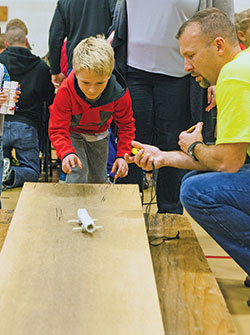2018 Catholic Schools Week Supplement
Catholic schools prepare ‘problem solvers’ bound by faith

Maddox Novotney launches his improvised “car” while Matt Maddox marks its speed with a timer during the second annual Family STEM Night on Nov. 16, 2017, at St. Barnabas School in Indianapolis. (Submitted photo)
(Editor’s note: Science, technology, engineering and math. These four areas comprise what has come to be known as STEM fields—areas of projected job growth by as much as 28 percent by 2024.
Catholic schools around central and southern Indiana are finding creative ways to introduce these areas to their students—and even to parents.)
By Natalie Hoefer
Megan Schaller and Ryan Scharr have become both coaching staff and cheerleaders when it comes to the STEM approach at St. Barnabas School in Indianapolis.
The two recently completed the Trustey Family STEM Teaching Fellows program through the Center for STEM Education at the University of Notre Dame. The program focuses on increasing student interest and learning in STEM disciplines through the support and growth of high‑quality STEM teachers.
Since starting the program in 2015, they have worked with other teachers at St. Barnabas to incorporate STEM projects and concepts into their curricula, even in religion and language arts classes.
“A STEM lesson is when you take any two letters or more [from the acronym], and both are being used and graded in a project,” explains Schaller, the school’s STEM coordinator and fifth- and sixth-grade science teacher. “Teachers plan a full STEM project, and each teacher sees how they can fill in,” such as using a religion class to brainstorm how STEM components could be used to address social justice issues like poverty, then writing about the topic in an English class.
But class time is limited. So in the fall of 2015, the school implemented STEM Days. One Friday each month is set aside to focus entirely on completing a project.
“The students enjoy that they get to do a whole project from beginning to end,” says Scharr, the school’s assistant principal. “They’re given a problem with real-world effects, and use what they learn to work with other people. They have to collaborate, engage socially, take leadership roles.”
The momentum didn’t stop there.
“Parents hear from kids [that] they love STEM,” says Schaller. “We wanted parents to see kids engaging in STEM challenges, and also themselves to do a [project] or problem-solve or test. … There are a lot of emotions involved in taking on real world challenges. [We wanted them] to see what it’s like to be frustrated or be exhilarated at success.”
So in the fall of 2016, the school hosted its first Family STEM Night. More than 300 parents and students took part in the two-hour event working on projects together. The second annual event last fall drew nearly 600 parents and children.
“There’s this void in the world today of problem solvers,” says Scharr. “We’re doing our best at St. Barnabas [to see] that all of our students, regardless of gender or socio-economic status or cultural background, can work together to solve problems, to take real world struggles and brainstorm solutions.” †
